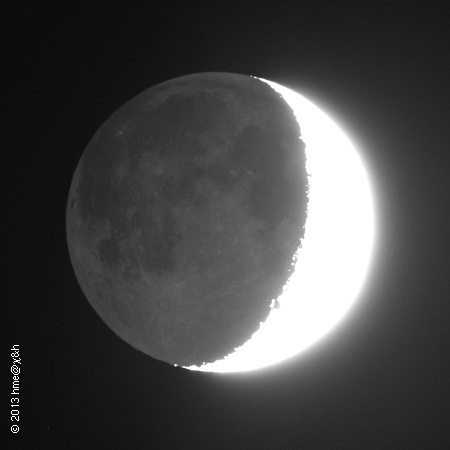
{
Practical astronomy
|
Astronomy
|
The Moon
|
Physical ephemeris
|
Earth shine
}
Earth shine
When we have a New Moon, an observer on the near side of the Moon would see a Full Earth in their night sky. The Earth is not only larger than the Moon, it is also more reflective – Full Earth nights on the Moon are much brighter than Full Moon night on Earth. When the lunar crescent is thin, we can actually see the "dark" side of the Moon illuminated by the Earth.
Physical parameters:
- Average distance: 384,000 km
- Radius: 1740 km
- Mass: 1/81 MEarth
- Surface gravity: 1/6 gEarth
Although the Earth shine is readily seen with the naked eye, taking an image will require a long focal length, as always with the Moon. A tripod will not really be sufficient; the required exposure tends to be several seconds so that tracking the Moon with a motorised equatorial mount will be very helpful. Another problem is the immense contrast between the bright crescent and the Earth shine. It requires high quality optics to avoid the glare from the crescent interfering with the feeble light from the dark side. A telescope objective is better suited to this task than most photographic lenses. This object can be a good application of high dynamic range processing, where several frames of decreasing exposure are combined and cleverly filtered (tone-mapped) to retain some contrast both in the faint and the bright parts of the object. The image shown here is just a single exposure, and so the lunar crescent is simply overexposed.
Image parameters:
- Camera: Canon EOS 600Dα
- Detector: 22 × 15 mm
- Focal length: 560 mm
- Field of view: 1.5 × 1.5°
- Aperture: 80 mm
- ISO: 1600
- Exposure: 5 s
- Location: Edinburgh
- Processing: logarithmic stretch

